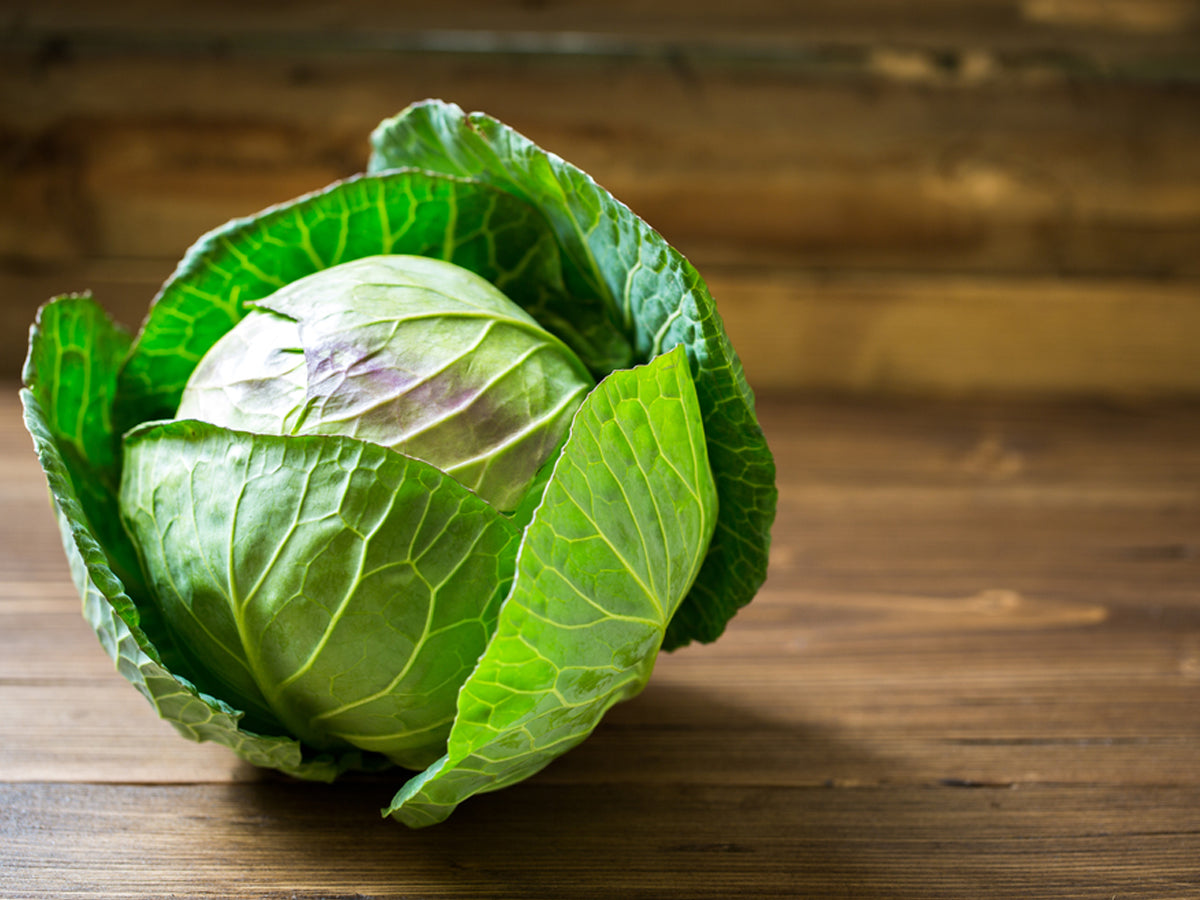How to Grow
Cabbage: Facts, Benefits, How to Grow at Home Easily & Care Tips
This vegetable is quite underrated, yet popular. How?
The deep-fried spring rolls, steamed momos, or street-side chowmein would only be possible with a generous dose of this leafy and crunchy vegetable.
Yes, we are talking about cabbage. One of the most well-known winter vegetables is cabbage, which is typically cooked with peas, potatoes, and carrots in Indian households.
Some say eating it raw is healthier, and some opine the cooked version leads to better digestion.
Cabbage is nutritious in any form because it is high in vitamin C and dietary fiber.
If you are fond of gardening or are a beginner, you can grow cabbage at home as it requires minimal care.
We will guide you through the whole process. In this blog, we will discuss the following: -
- Interesting facts to know about cabbages
- Significant health benefits of cabbage
- How to grow cabbages at home
- How to take care of cabbages
So let’s start peeling the layers of cabbage.
Interesting facts to know about cabbages
- Our regular cabbage has plummeted from the wild cabbage, and belongs to the "cole crops" or brassicas, meaning it is closely related to broccoli and cauliflower
- Do you know that cabbage is called the national food of Russia?
- Russia has the highest annual per capita consumption of cabbage followed by Belgiu, and the Netherlands
- It’s interesting to know that the Chinese scrolls from around 1000 BC mention using cabbage to treat male pattern baldness. This may be the reason why legendary baseball player Babe Ruth reportedly swapped out the cabbage leaf he was wearing under his baseball cap midway through games.
- The ancient Greeks advocated using vegetables as a laxatives. Cabbage juice was used as an eye ointment and a remedy for mushroom poisoning.
- During World War I, Britain employed the leaves' cooling powers to cure trench foot and as compresses for breast abscesses and ulcers.
Significant health benefits of cabbage
Packed with essential nutrients, you cannot ignore cabbage on your plate. Here is the nutritional value and probable health benefits of cabbage: -
|
Calories |
25 |
|
Calcium |
0.04 |
|
Carbohydrates |
6g |
|
Fat |
0.1g |
|
Iron |
2% of daily recommended value |
|
Magnesium |
3% of daily recommended value |
|
Potassium |
170mg |
|
Protein |
1.3g |
|
Sodium |
18mg |
|
Vitamin A |
1% of daily recommended value |
|
Vitamin B6 |
5% of daily recommended value |
|
Vitamin C |
60% of daily recommended value |
A great anti-inflammatory agent
Glutamine is one amongof the key components of the admium-binding complexes found in cabbage leaves. Due to its potent anti-inflammatory properties, the glutanin found in cabbage helps to lessen the symptoms of many skin conditions, allergies, joint discomfort, fever, and different types of inflammation. The anti-inflammatory effects of this cruciferous group of plants, including cabbage, are probably brought on by sulforaphane, kaempferol, and other antioxidants. These antioxidants keep inflammatory diseases in check.
Guards against radiation
Cabbage contains a substance called 3,3-diindolylmethane (DIM), which can shield you against the negative effects of radiation therapy. More research has shown that DIM may be employed as a barrier to protect healthy tissues during cancer treatment in addition to protecting you from cancer.
Aids in weight loss
Cabbage can be part of a diet plan for those who desire to reduce weight. It is low in calories and carbohydrates, and high in vitamins, minerals, and other nutrients. So, you can eat a lot of it without getting too fat.
Improves digestion
Cabbage is an excellent source of fiber if you want to improve your digestive system. It is loaded with insoluble fiber, a form of carbohydrate that can't be digested in the intestines, which is good for the gut. Insoluble fiber makes stools more substantial and encourages regular bowel movements, helping to maintain a healthy digestive system.
May fight cancer
Because it contains sulforaphane, cabbage may reduce cancer risk. Cancers like melanoma, esophageal, pancreatic, and prostate cancer can all be slowed down or prevented by sulforaphane. The ability of sulforaphane to stop the growth of cancer cells, has been demonstrated by research. In an aggressive form of breast cancer, apigenin, another molecule found in cabbage juice, helps shrink the tumor.
Regulates blood pressure & keeps heart healthy
The likelihood of having a heart attack or stroke rises with elevated blood pressure. Consuming cabbage lowers your risk of developing any heart conditions and helps to maintain healthy blood pressure. This is because potassium, a vasodilator that helps to open up blood vessels and ease blood flow, is present in cabbage.
Apart from the regular ones, the red and purple cabbages are wonderful for skin care and is utilized for skin lightening and radiance. Since cabbage is high in Vitamin C, which has remarkable anti-aging properties and aids in the development of healthy, radiant skin.
How to grow cabbages at home
Growing outdoors in your garden
Choose a variety
Your harvest will last longer if you plant several different types with various maturities. You'll enjoy fresh cabbage for a more extended period if your cabbages mature at multiple dates.
Prepare seeds inside
If you want to grow cabbage from seeds, prepare the seeds inside before taking them outside. Then, sow the seeds 1/4th inch deep in the soil and 2 inches apart, and place them under full sunlight.
Prepare soil
Till the selected spot in your garden up to 2 inches deep, followed by mixing compost. Above the compost, put a layer of manure or balanced fertilizer. After preparing the soil, water it thoroughly.
Cabbage sprout
You will notice sprouts in 7-10 days. Take care of them with consistent water and sunlight.
Transplant outside
After 3-4 weeks, when the seedlings have grown a bit, you must bring them outside. Give your cabbage lots of sun exposure by arranging them in rows. Ideally, cabbage needs six hours of direct sunlight each day. The heads of your cabbage will grow more prominent when they receive an adequate amount of sunlight. Place the seedlings with 12 to 24 inches of space between the rows.
Complementary plants
It would be great if you could place the cabbage plants near complementary plants like cucumbers, celery, onions, beans, potatoes, lettuce, spinach, dill, or kale. Why? That's because these plants will promote healthy growth for cabbages. For example, helpful wasps that eliminate cabbage worms and other pests are drawn to dill, which protects your cabbage from them.
Protection against pests
You can use netting and row coverings to shield your cabbage from airborne pests.
Water & Mulch
Cabbage loves moist soil. So, apply water and mulch for 2 inches every week. Mulch will help the soil retain moisture.
Fertilizing time
After three weeks of planting, fertilize the ground. For optimum development, use a fish emulsion or other liquid fertilizer. Soon after your cabbage starts to grow new leaves, add the fertilizer. Then, when the plants start creating heads, add the fertilizer again.
Harvest
Depending on the variety chosen, cabbages would take anywhere between 60-120 days to mature and be ready for harvest.
Growing indoors in a pot
Planter
Get a planter that is 10 inches deep and 12 inches wide for planting your cabbage plant. Place the planter on a drip tray filled with a layer of gravel.
Soil
Now, add rich, loamy soil to your pot and mix in a layer of compost. Also, apply a thin layer of manure or balanced fertilizer on top of it.
Planting seeds
Place a cluster of three cabbage seeds that are 12 inches apart. Put a toothpick between the seeds to indicate their placement, and cover them with half an inch of soil.
Placing and watering
Now put the pot in a bright, sunny corner of your indoor space. Remember, the more sunlight the plant gets, the better your cabbage turns out.
Remember to water your plants daily after checking the soil. That’s because soggy soil will invite diseases.
Thinning
Remove the two plants from each cluster that appear the scraggiest or weakest after about six weeks. The cabbage heads ought to have grown by now.
Fertilizer
When the cabbage begins to develop a head, fertilize the soil with NPK 20-20-20 fertilizer. Add the recommended amount of fertilizer to the soil.
Harvest
When the cabbage head is hard and fully developed, it is time to harvest it. To test, gently pinch the head. The cabbage is still not ready if it is still tender. Harvesting will take 60-100 days, depending on the variety of cabbage planted.
How to take care of cabbages
Follow the instructions below and take care of cabbage plants: -
Sunlight
Cabbage grows best in full sun. It means cabbages would require six hours of minimum sunlight daily. However, it can also withstand light shade, particularly in warm areas.
Location
Dedicate the sunniest spot on your terrace or balcony to grow cabbage plants, as they can enjoy the warm sun for a long time. If the temperature is high, offer some shade.
Soil
Cabbage is mainly grown on sandy to heavy soils rich in organic materials. Early crops favor light soil, whereas late crops benefit more from heavy soils due to moisture retention. The ideal pH range for growing cabbage is between 6.0 and 6.5. Remember that saline soils make plants more susceptible to disease.
Opt for a well-draining loamy soil rich in organic for your indoor growing pots. Also, add a layer of compost before planting seeds.
Temperature
A cool but moist environment is what cabbage plants love the most. The ideal temperature would be between 15 and 21 degrees Celsius.
Fertilizer
A side dressing with compost every few weeks is essential. The use of fish emulsion or other liquid fertilizers is also recommended. Alternatively, you may also apply an organic vegetable fertilizer with a balanced ratio of potassium, phosphorus, and nitrogen (10-10-10 NPK).
Water
A consistent supply of water will make cabbages crispier and juicier. Irregular watering will lead to harshly flavored and malformed cabbages. An inch of water per week is sufficient for cabbage plants. Mulching is essential to help the soil retain moisture.
We hope we have made growing cabbage at home more manageable for you. So, get your gloves and other gardening equipment to spend time cultivating this leafy vegetable and enjoy its myriad health benefits. It only requires your attention to growing well.
Happy gardening!
FAQs Related to Cabbage
Which is healthier – raw or cooked cabbage?
Cabbage is a healthy vegetable that is eaten both in raw and cooked form. Raw cabbage is used in various salads. But according to Scientific American, all cruciferous vegetables like cabbage, cauliflower, and broccoli release Indole – an organic compound that can combat precancerous cells. Also, raw cabbage may cause digestive issues in some people.
How long it takes to grow cabbages?
It takes four to six months for cabbages to grow and mature, depending on the variety chosen.
In which season are cabbages grown in India?
Early cabbage is sown between July and November in lowlands and between April and August in hills since the former requires more time to develop its heads.
Is eating cabbage healthy?
Yes, cabbage contains essential vitamins and antioxidants that offer various health benefits. Eating cabbage will promote bone health, promote good skin, improve eyesight, help digestion, and fight cancer.



